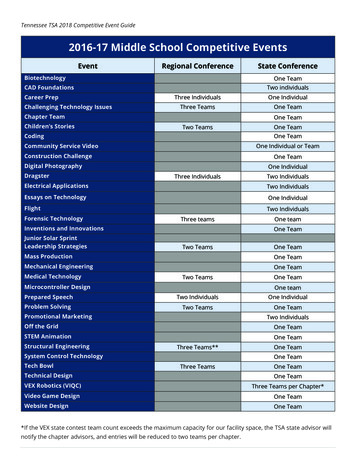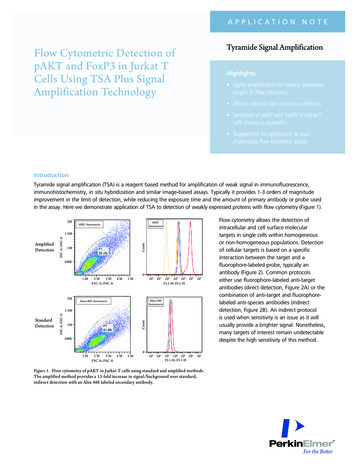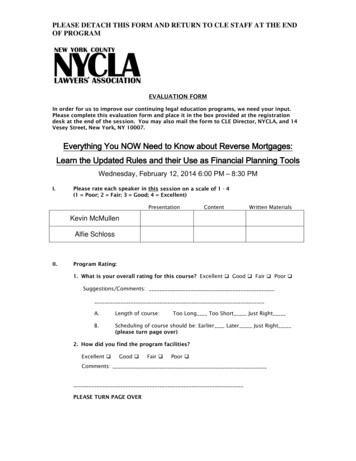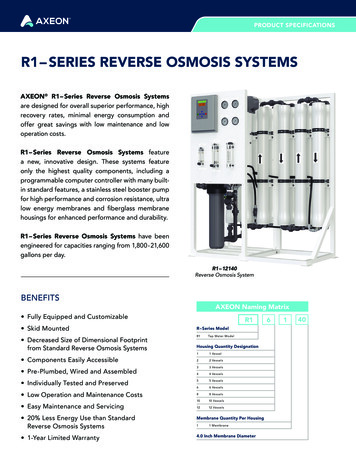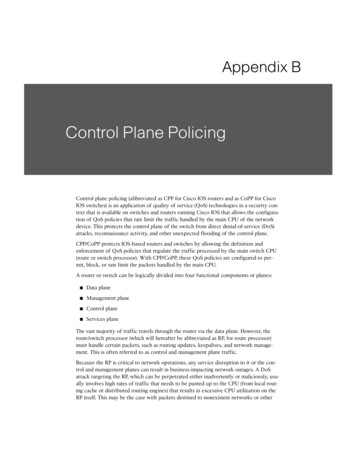
Transcription
Department of Rehabilitation ServicesReverse Total Shoulder Arthroplasty with Latissimus dorsi tendon transferProtocol:General Information:Reverse or Inverse Total Shoulder Arthroplasty (rTSA) is designed specifically for the treatmentof glenohumeral (GH) arthritis when it is associated with irreparable rotator cuff damage,complex fractures as well as for a revision of a previously failed conventional Total ShoulderArthroplasty (TSA) in which the rotator cuff tendons are deficient.The rTSA prosthesis reverses the orientation of the shoulder joint by replacing the glenoid fossawith a glenoid base plate and glenosphere and the humeral head with a shaft and concave cup.This prosthesis design alters the center of rotation of the shoulder joint by moving it mediallyand inferiorly. This subsequently increases the deltoid moment arm and deltoid tension, whichenhances both the torque produced by the deltoid as well as the line of pull / action of the deltoid.This enhanced mechanical advantage of the deltoid compensates for the deficient RC as thedeltoid becomes the primary elevator of the shoulder joint. This results in an improvement ofshoulder elevation and often individuals are able to raise their upper extremity overhead.Outcomes for patients following rTSA with teres minor deficiency have been significantlylimited in terms of active external rotation, particularly with shoulder elevation. Typicallyindividuals with an intact teres minor have a mean of 15 degrees improvement of active externalrotation following rTSA yet individuals who have a deficient teres minor demonstrate noimprovement of active external rotation postoperatively. Therefore, in cases where the teresminor is deficient or absent a surgeon may elect to perform a latissimus dorsi tendon transfer(LDTT) to compensate for the teres minor deficiency. The latissimus dorsi muscle is well suitedto transfer for several reasons, including its large surface area, strength, and goodvascularization. All of these factors are important when considering how this muscle will recoverfollowing surgery, particularly the muscle’s vascularity as an adequate supply of nutrients isessential for the healing processes to occur.The mechanics of the shoulder complex following rTSA with a LDTT are, as expected, differentfrom a native shoulder. For example, in its normal anatomical position, the latissimus dorsimuscle acts as an extensor of the humerus, yet after being transferred it becomes a humeral headReverse Total Shoulder Arthroplasty with Latissimus dorsi tendon transfer ProtocolCopyright 2016 The Brigham and Women's Hospital, Inc. Department of Rehabilitation Services. All rightsreserved.1
Department of Rehabilitation Servicesstabilizer creating an external rotation moment around the rTSA components. This conversion toa humeral head stabilizer and external rotator is important as it now allows the joint to functionmore efficiently as it compensates for the actions of the deficient teres minor. The biomechanicsof the postoperative shoulder allow for more effective action of the deltoid, which is importantduring various daily activities that incorporate elevation and abduction movements.The rotator cuff is absent with the rTSA and LDTT; therefore, the rehabilitation for a patientfollowing the rTSA and LDTT is different than the rehabilitation following a traditional TSA.The surgeon, physical therapist and patient need to take this into consideration when establishingthe postoperative treatment plan. Important rehabilitation management concepts to consider for apostoperative physical therapy rTSA and LDTT program are: Joint protection: There is a higher risk of shoulder dislocation following rTSA andLDTT when compared to a conventional TSA.o Patients following a rTSA with LDTT do not dislocate with the arm in abductionand external rotation. They will typically dislocate with the arm in internalrotation and adduction in conjunction with extension. For example, tucking in ashirt or performing bathroom / personnel hygiene with the operative arm is adangerous activity particularly in the immediate peri-operative phase.o Avoidance of shoulder extension beyond neutral with the combination of shoulderadduction and internal rotation for a minimum of 12 weeks postoperatively.o It is important to avoid over stretching or putting excessive tension on the healingtransferred latissimus dorsi tendon. No aggressive internal rotation, flexion, oradduction is advised. Deltoid function: Stability and mobility of the shoulder joint is now dependent upon thedeltoid and periscapular musculature. This concept becomes the foundation for thepostoperative physical therapy management for a patient following rTSA with LDTT. Function: As with a conventional TSA, maximize overall upper extremity function,while respecting soft tissue constraints. ROM: Expectation for range of motion gains should be set on a case-by-casebasis depending upon underlying pathology. Normal/full active range of motionof the shoulder joint following rTSA with a LDTT is not expected.Reverse Total Shoulder Arthroplasty with Latissimus dorsi tendon transfer ProtocolCopyright 2016 The Brigham and Women's Hospital, Inc. Department of Rehabilitation Services. All rightsreserved.2
Department of Rehabilitation ServicesFigure 1. Anterior Posterior radiograph (A) and illustration (B) of a left shoulder with rotatorcuff arthropathy. The superiorly migrated humeral head indicates rotator cuff deficiency.ABFigure 2. Reverse Total Shoulder Arthroplasty Components (Zimmer, Warsaw, IN). The prosthesis has 5 parts: theglenoid base, the glenosphere, a polyethylene cup, humeral neck, and the humeral stem.TAFigure 3. Anterior Posterior radiography of a right shoulder (A) and an illustration of a left shoulder (B) after reversetotal shoulder arthroplasty.ABReverse Total Shoulder Arthroplasty with Latissimus dorsi tendon transfer ProtocolCopyright 2016 The Brigham and Women's Hospital, Inc. Department of Rehabilitation Services. All rightsreserved.3
Department of Rehabilitation ServicesReverse Total Shoulder Arthroplasty with Latissimus Dorsi Tendon Transfer Protocol:The intent of this protocol is to provide the physical therapist with a guideline/treatment protocolfor the postoperative rehabilitation management for a patient who has undergone a Reverse TotalShoulder Arthroplasty (rTSA) with lastissimus dorsi tendon transfer (LDTT). It is by no meansintended to be a substitute for a physical therapist’s clinical decision making and should be basedon the individual patient’s physical exam/findings, progress, and/or the presence of postoperativecomplications. If the physical therapist requires assistance in the progression of a postoperativepatient who has had rTSA and LDTT the therapist should consult with the referring surgeon.The scapular plane is defined as the shoulder positioned in 30 degrees of abduction and forwardflexion with neutral rotation. ROM performed in the scapular plane should enable appropriateshoulder joint alignment.Shoulder Dislocation Precautions: No shoulder motion behind the patient’s back. (NO combined shoulder adduction,internal rotation, and extension.) No glenohumeral (GH) extension beyond neutral.*Precautions should be implemented for 12 weeks postoperatively unless the surgeonspecifically advises patient or therapist differently.Surgical Considerations: The surgical approach needs to be considered when devising the postoperative plan ofcare. Traditionally rTSA with LDTT procedure is performed via a typical lengtheneddeltopectoral approach, which minimizes surgical trauma to the anterior deltoid andexposes the latissimus dorsi tendon. The latissimus dorsi tendon is identified, afterreleasing the pectoralis major tendon while protecting the radial and axillary nerve. Thelatissimus dorsi is then mobilized and pulled around the posterior aspect of the humeralhead and attached to the greater tuberosity region of the humerus. The start of this protocol is typically delayed 2-4 weeks following rTSA with LDTT in arevision situation and/or in the presence of poor bone stock based on thesurgeon's assessment of the integrity of the surgical repair.Reverse Total Shoulder Arthroplasty with Latissimus dorsi tendon transfer ProtocolCopyright 2016 The Brigham and Women's Hospital, Inc. Department of Rehabilitation Services. All rightsreserved.4
Department of Rehabilitation Services*Progression of phases is based on clinical criteria and timeframes as appropriate.Phase I – Immediate Post Surgical Phase/Joint Protection (Day 1-6 weeks):Phase I ADL’s Avoid all activities using operative upper extremity for first 4 weeksexcept for those done with the physical therapist. Clothing: Oversized button down shirts, women should avoid wearingbras for the first 4wksGoals: Patient and family independent with:o Joint protectiono Assisting with putting on/taking off gunslinger or ER slingand clothingo Cryotherapy Promote healing of soft tissue / maintain the integrity of the replaced joint and transferredtendon. Restore active range of motion (AROM) of elbow/wrist/hand. Independent with bed mobility, transfers and ambulation or as per pre-admission status.(NWB for this extremity)Phase I Precautions: Patient is immobilized in an at least neutral to 15 degrees of external rotation in the planeof the scapula to keep the transferred tendon in a shortened protected position to enhancehealing. They is either done with a gunslinger or an external rotation sling, per MDrecommendation. While lying supine, the distal humerus/ elbow should be supported by a pillow or towelroll to avoid shoulder extension. Patients should be advised to “always be able tovisualize their elbow while lying supine.” No shoulder AROM or passive range of motion (PROM). No lifting of objects with operative extremity. No supporting of body weight with involved extremity. Keep incision clean and dry (no soaking/wetting for 2 weeks); No whirlpool, Jacuzzi,ocean/lake wading for 4 weeks.Acute Care Therapy (Day 1 to 4): Active/Active Assisted ROM (A/AAROM) of cervical spine, elbow, wrist, andhand.Begin periscapular sub-maximal pain-free isometrics in the scapular plane.Reverse Total Shoulder Arthroplasty with Latissimus dorsi tendon transfer ProtocolCopyright 2016 The Brigham and Women's Hospital, Inc. Department of Rehabilitation Services. All rightsreserved.5
Department of Rehabilitation Services Continuous cryotherapy for first 72 hours postoperatively, then frequent application (4-5times a day for about 20 minutes).Insure patient is independent in bed mobility, transfers and ambulationInsure proper gunslinger fit/alignment/ use.Instruct patient in proper positioning, posture, initial home exercise program.Provide patient/ family with written home program including exercises and protocolinformation.Day 5 to 28: Patient continues all exercises as above at home. Frequent (4-5 times a day for about 20 minutes) cryotherapy.4 Weeks to 6 Weeks: Patient typically begins formal outpatient physical therapy. Progress exercises listed above. Begin sub-maximal pain-free deltoid isometrics in scapular plane (avoid shoulderextension when isolating posterior deltoid.) Begin shoulder PROM:o Forward flexion and elevation in the scapular plane in supine to 120 degrees astolerated.o NO IR PROM at this time.o ER in scapular plane to tolerance, respecting soft tissue constraints (typically 3040 degrees of ER). Continue frequent cryotherapy.Criteria for progression to the next phase (Phase II): Tolerates shoulder PROM and deltoid isometrics; and AROM program for elbow, wrist,and hand. Patient demonstrates the ability to isometrically activate all components of the deltoidand periscapular musculature in the scapular plane.Phase II –Active Range of Motion / Early Strengthening Phase (Week 6 to 12):Phase II ADL’s Independent dressing and showering below 90deg shoulder elevationand with upper extremity in front of patient. Use caution to prevent jerking motions when don/doffing clothing. Use of operative arm to eat/drink and perform light activities. No lifting of objects more than 2-3 pounds with operative upperextremity.Reverse Total Shoulder Arthroplasty with Latissimus dorsi tendon transfer ProtocolCopyright 2016 The Brigham and Women's Hospital, Inc. Department of Rehabilitation Services. All rightsreserved.6
Department of Rehabilitation ServicesGoals: Continue progression of PROM (full PROM is not expected).Gradually restore AROM.Facilitate latissimus dorsi to function as a humeral head stabilizer and external rotator.Control pain and inflammation.Allow continued healing of soft tissue / do not overstress healing tissue.Re-establish dynamic shoulder and scapular stability.Precautions: If the patient was in a gunslinger they are weaned out of it into and ER sling at post-opweek # 6. Goal is to be weaned out of sling by post-op week # 8 if adequate shouldermotor control (i.e. negative ER lag sign and the ability to actively elevate shoulder atleast 50 degrees without pain.) No forced shoulder ROM Restrict lifting of objects to no heavier than a coffee cup. No supporting of body weight by involved upper extremity.Week 6 to Week 8: Continue with PROM program.o At 6 weeks post op start PROM IR to tolerance (not to exceed 30 degrees) in thescapular plane. Begin Active assisted range of motion (AAROM) and AROM (Begin in supine andsidelying then progress to antigravity positions as appropriate) Forward Flexion (lawn chair progression) * Forward elevation * External Rotation * Internal Rotation*Use ofa biofeedback is helpful for visual and auditory feedback to reeducate the Latissimus muscle to function as an external rotator.Neuromuscular electrical stimulation (NMES) is useful to assist in muscularrecruitment as well. Initiate gentle scapulothoracic rhythmic stabilization and alternating isometrics insupine as appropriate. Begin gentle periscapular and deltoid sub-maximal painfree isotonic strengthening exercises, typically toward the end of the 8th week. Progress strengthening of elbow, wrist, and hand. Gentle glenohumeral and scapulothoracic joint mobilizations as indicated (GradeI and II).Reverse Total Shoulder Arthroplasty with Latissimus dorsi tendon transfer ProtocolCopyright 2016 The Brigham and Women's Hospital, Inc. Department of Rehabilitation Services. All rightsreserved.7
Department of Rehabilitation Services Continue use of cryotherapy as needed.Patient may begin to use hand of operative extremity for feeding and light activities ofdaily living including dressing, washing.Week 9 to Week 12: Continue with above exercises and functional activity progression. Begin AROM supine forward flexion and elevation in the plane of the scapula with lightweights (1-3lbs. or .5-1.4 kg) at varying degrees of trunk elevation as appropriate. (i.e.supine lawn chair progression with progression to sitting/standing). Progress to gentle glenohumeral IR and ER isometric and isotonic strengtheningexercises in sidelying position with light weight (1-3lbs or .5-1.4kg) and/or with lightresistance resistive bands or sport cords.Criteria for progression to the next phase (Phase III): Improving function of shoulder. Patient demonstrates the ability to isotonically activate all components of the deltoid andperiscapular musculature and is gaining strength.Phase III – Moderate strengthening (Week 12 )Phase III ADL’s Independent with all ADL’s including dressing, showering, eating. Return to light to moderate activities below shoulder height as tolerated. No lifting of objects with more than 5 pounds with operative extremity.Goals: Enhance functional use of operative extremity and advance functional activities. Enhance shoulder mechanics, muscular strength and endurance.Precautions: No lifting of objects heavier than 2.7 kg (6 lbs) with the operative upper extremity belowchest height No sudden lifting or pushing activities.Week 12 to Week 16: Continue with the previous program as indicated. Progress to gentle resisted flexion, elevation in standing as appropriate.Reverse Total Shoulder Arthroplasty with Latissimus dorsi tendon transfer ProtocolCopyright 2016 The Brigham and Women's Hospital, Inc. Department of Rehabilitation Services. All rightsreserved.8
Department of Rehabilitation ServicesPhase IV – Continued Home Program (Typically 4 months postop)::Phase IV ADL’s No lifting of objects more than five pounds with operative extremity and10 pounds with both extremities. Progression of light to moderate activities with operative upperextremity within available AROM and with upper extremity in front ofbody. Typically the patient is on a home exercise program at this stage to be performed 3-4times per week with the focus on: Continued strength gains Continued progression toward a return to functional and recreational activities withinlimits as identified by progress made during rehabilitation and outlined by surgeon andphysical therapist.Criteria for discharge from skilled therapy: Patient is able to maintain pain free shoulder AROM demonstrating proper shouldermechanics. (Typically 90 – 120 degrees of elevation with functional ER of up to 10-15degrees.) Typically able to complete light household and work activities.Authors:Reg B. Wilcox III , PTStephanie Boudreau, PT6/08Updated 4/09Reviewed 6/16Reviewers:Laurence D. Higgins, MDKathryn Wilson, SPTReverse Total Shoulder Arthroplasty with Latissimus dorsi tendon transfer ProtocolCopyright 2016 The Brigham and Women's Hospital, Inc. Department of Rehabilitation Services. All rightsreserved.9
The intent of this protocol is to provide the physical therapist with a guideline/treatment protocol for the postoperative rehabilitation management for a patient who has undergone a Reverse Total Shoulder Arthroplasty (rTSA) with lastissimus dorsi tendon transfer (LDTT). It is by no means



